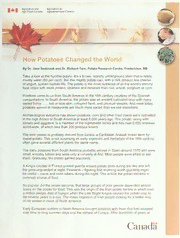
How potatoes changed the world. PDF
Preview How potatoes changed the world.
1*1 Agricultureand Agricultureet Agri-Food Canada AgroalimentaireCanada How Potatoes Changed the World By Dr. Jane Seabrook and Dr. Richard Tarn, Potato Research Centre, Fredericton, NB Take a look at the humble potato. It's a brown, starchy underground stem that is really mostly water (80 per cent). But this mighty potato can, with a milk product like cheese or yogurt, sustain human life. The potato is the most nutritious of all the world's starchy food crops with more protein, vitamins and minerals than rice, wheat, sorghum or corn. Potatoes came to us from South America in the 16th century courtesy ofthe Spanish conquistadors. In South America, the potato was an ancient cultivated crop with many varied forms red or blue skin, coloured flesh, and unusual shapes. And even today, potatoes served in restaurants are much more varied than we see elsewhere. Archaeological evidence has shown potatoes, corn and other food plants were cultivated in the high Andes of South America at least 8,000 years ago. The potato, along with tomato and eggplant, is a member of the nightshade family and has over 2,000 relatives world-wide, of which less than 200 produce tubers. The term potato is probably derived from batata, a Caribbean Arawak Indian term for sweet potato. This is not surprising as early explorers and herbalists ofthe 16th century often gave several different plants the same name. The early potatoes from South America probably arrived in Spain around 1570 and were small, knobbly tubers and were only a curiosity at first. Most people were afraid to eat them. Gradually, the potato gained popularity. A King's courtier in France posted guards around potato plots during the day and left the plots unguarded at night. Peasants - figuring that anything worth guarding might be useful - came and stole tubers during the night. This is how the potato became a common source of food. So popular did the potato become, that large groups of poor people depended almost solely on the potato for food. This was the origin of the Irish potato famine in which over a million people died of hunger when the Late Blight fungus caused the potato crop to fail several years in a row. The mass migration of Irish people looking for a better way of life settled in much of North America. Early European settlers to North America brought potatoes with them that had adapted over time to long summer days and the climate of Europe. After hundreds of years of Canada adaptation, these potatoes looked little like the indigenous South American potatoes. Later some potato varieties were brought to North America from Central and South America. One of the early introductions was Garnet Chili, a long, red-skinned curiosity. Potatoes grown in Canada by early settlers were not particularly well adapted to our cold spring soils and short growing season. Slowly, farmers selected strains which suited Canadian conditions. AAFC conducts research on many of the world's leading food crops at several of its 19 Research Centres located across Canada. Because oftheir high nutritional value, potatoes continue to be an attractive food source in developing countries. The growth in potato production world-wide is happening in warm climates. Much of the effort of the International Potato Centre in Lima, Peru, one of a number of crop development centres around the world, is devoted to adapting the potato as a winter window crop for hot climates. Several North American potato processing companies have recently opened seed potato growing facilities and French fry plants in China, signalling interest in the potato to the world's most populous nation. So the next time you dig into a delicious shepherds pie, perogies, poutine, or a plate of fish and chips, remember that the humble potato came to us from the high mountains of the Andes via the Spanish galleons to Europe and then with our European ancestors to Canada. For more information, visit www.agr.gc.ca . This textis adapted from an article originallypublishedin the newsletterofthe Fredericton (NB) Botanic Garden Association. 18(1): Winter2006. ©HerMajestytheQueen in RightofCanada, 2008 Cat. No. A22-477/2008E ISBN 978-0-662-48399-1 AAFC NO.10764E Aussioffertenfrancaissous letitre : Commentlapommedeterrea-t-ellechangelemonde?
